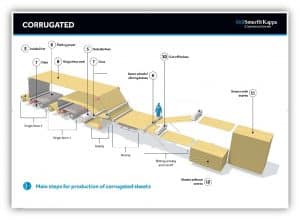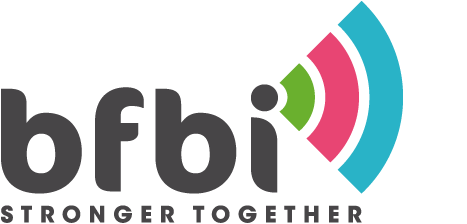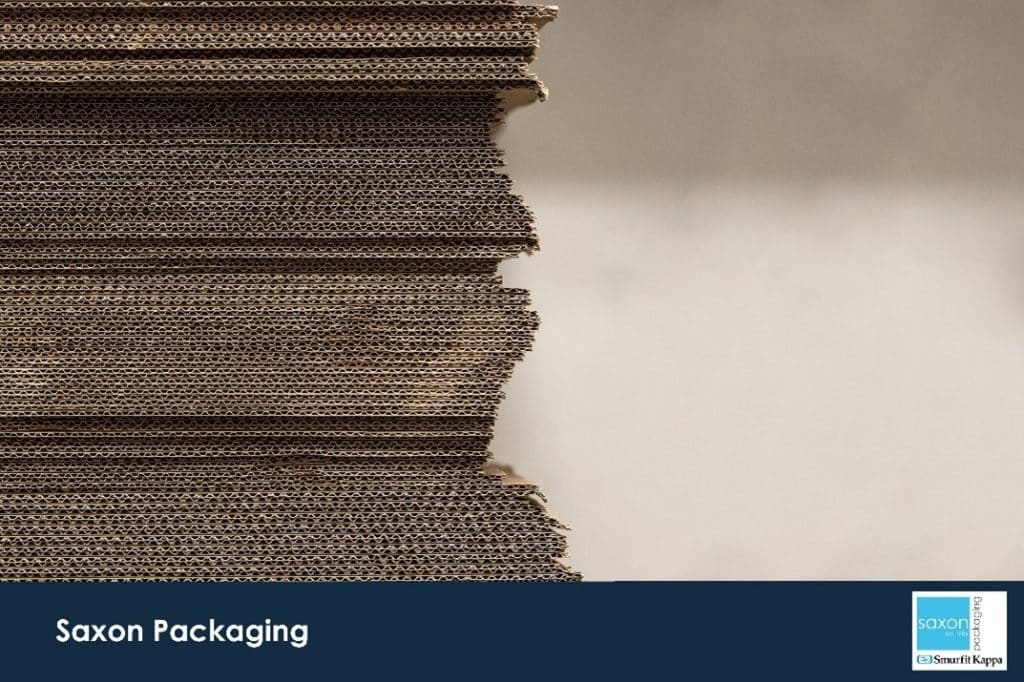What is corrugated board?
Corrugated board is a material consisting of a fluted corrugated sheet and up to two flat linerboards. The fluted sheet and linerboards are then glued together to form corrugated board. This is made using special machines called corrugators and is essential in the process for making cardboard boxes. Corrugated board is sometimes referred to as corrugated fibreboard, corrugated cardboard, and paperboard.

Originally developed as packaging solution in 1871, corrugated board and the packaging industry as a whole has incurred incremental innovations over the last century, enabling corrugated board to have multiple uses and functions in the current day.
Find out more about the history of corrugated.
What types of corrugated board are available?

Corrugated board is available in many different material grades with varying paper weights and finishes. All of our materials at Saxon Packaging are sourced from within Smurfit Kappa Group, to ensure our material is cost effective and of the highest quality.
Standard finishes include KRAFT (brown) white & mottled/oyster, LT (recycled paper) and TEST (recycled inner liner). White papers can be coated to provide superior substrate for greater print quality.
Standard nominal paper thicknesses start at 85gsm (grams per square metre) and increase up to 275gsm. Different flute weights are also available and is determined by the strength of material required.
Forest Stewardship Council (FSC) – What is Chain of Custody Certification?
All of our corrugated board that we utilise is chain of custody certified under FSC.
The FSC is an international, non-governmental organisation dedicated to promoting responsible management of the world’s forests.
They have developed a system of forest certification and product labelling that enables people to identify responsibly sourced wood, paper and other forest products.
Chain of Custody Certification (COC) is an internationally recognised system, of ensuring that a product of forestry origin has originated from a legal and responsible source. It ensures traceability from the original logging phase, the journey throughout the entire supply chain and the eventual delivery to the merchants/manufacturers.
Corrugated Board Flute Profiles
Standard flute profiles that we work with at Saxon Packaging are E, S, B, C, BC and EB. Each of these materials are mentioned in greater detail below:
‘E’ Flute
1300 – 1600 microns (1.3mm – 1.6mm) in thickness and gives excellent crush resistance. It provides a high quality surface to print upon and is most commonly used in smaller cartons and die-cuts applications.
‘S’ Flute
1900 – 2200 microns (1.9 – 2.2mm) in thickness S flute is balanced perfectly for both retail and transit packaging. It sits between E and B Flutes to provide the performance characteristics of B Flute, whilst producing the outstanding printability and good strong crush resistance characteristics.
‘B’ Flute
2600 – 3000 microns (2.6mm – 3.0mm) in thickness and probably the most common type of fluting. Seen in all types of applications including die-cut and regular cases it gives a good all-round performance.
‘C’ Flute
3600 – 4200 microns (3.6mm – 4.2mm) in thickness it offers greater box compression strength than ‘B’ flute thus giving slightly better stacking strength for lighter products. It can be prone to more crushing if used in the wrong application.
‘EB’ Flute
3800 – 4300 microns (3.8mm – 4.3mm) in thickness this is a double wall material combining the fine ‘E’ flute and the commonly used ‘B’ flute. The results give an excellent performance level in both print finish and impact protection.
‘BC’ Flute
6100 – 6700 microns (6.1mm – 6.7mm) in thickness this is another double wall material that marries two flute profiles together – ‘B’ and ‘C’, both giving excellent all round performances this material is most often seen in shipping cases where a high protection level is required.





